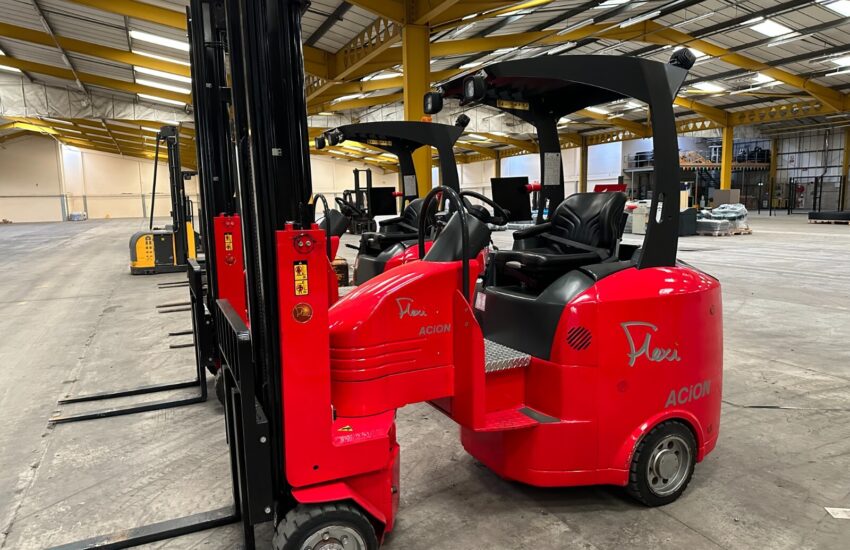When most people think of forklifts, they picture the standard warehouse workhorse—a compact yellow machine quietly moving pallets in the back of a retail store. But beyond the familiar sit-down counterbalance forklift lies a fascinating universe of specialized machines engineered for extreme environments, unusual cargo, and tasks that would make a regular forklift operator’s head spin.
The Titans of the Shipping World
At the apex of forklift engineering sit the container handlers—mechanical giants that dwarf their warehouse cousins. These behemoths can lift fully loaded shipping containers weighing up to 65 tons, stacking them six high in busy ports around the world. Standing over 50 feet tall when fully extended, these machines move with surprising precision despite their massive size.
The Kalmar Super Gloria, one of the largest container handlers ever built, can lift containers to heights of nearly 200 feet. To put this in perspective, that’s roughly the height of a 15-story building. These machines don’t just lift—they can rotate containers 90 degrees, allowing operators to efficiently transfer cargo between trucks, trains, and ships in the intricate choreography of global commerce.
Machines Built for Fire and Ice
Some of the most remarkable forklift variants are designed for environments that would destroy conventional equipment. Explosion-proof forklifts operate in chemical plants, refineries, and grain elevators where a single spark could trigger catastrophic fires or explosions. Every component—from the engine to the electrical systems—is specially designed to prevent ignition of flammable vapors.
At the other extreme, cold storage forklifts work in temperatures that can drop to -40°F in massive frozen food warehouses. These machines feature specialized hydraulic fluids that won’t freeze, heated operator compartments that feel more like spacecraft cockpits, and materials engineered to remain flexible in arctic conditions. The operators often work in full arctic gear, making precision lifting operations while battling condensation that can freeze on contact.
The Precision Artists
Some industries demand forklift variants with almost surgical precision. In the glass industry, specialized glass handlers use vacuum suction systems instead of traditional forks, lifting massive sheets of plate glass without leaving a single fingerprint or crack. These machines can manipulate pieces weighing several tons while maintaining tolerances measured in millimeters.
Paper roll handlers represent another triumph of specialized engineering. These machines are designed specifically to lift the enormous rolls of paper used in newspaper and magazine printing—some weighing over 3,000 pounds and standing taller than a person. The clamp mechanism must grip firmly enough to lift safely but gently enough to avoid damaging the delicate paper surface.
Going Where Others Can’t
Rough terrain forklifts, sometimes called “all-terrain forklifts,” blur the line between construction equipment and material handlers. With massive pneumatic tires, four-wheel drive, and ground clearance that rivals an SUV, these machines work on construction sites, lumber yards, and anywhere else that standard forklifts would get stuck in the mud.
Even more specialized are telescopic handlers, also known as telehandlers. These machines combine the lifting power of a forklift with the reach of a crane, using a telescoping boom that can extend 40 feet or more horizontally. They’re essential in construction, agriculture, and anywhere materials need to be placed in hard-to-reach locations.
The Narrow Aisle Masters
At the opposite end of the size spectrum are very narrow aisle (VNA) forklifts, designed to work in warehouse aisles as narrow as 5.5 feet. These tall, thin machines can lift loads to heights of 40 feet while navigating spaces so tight that operators need specialized training just to turn around.
The most extreme versions are automated guided vehicles (AGVs) that work in “lights-out” warehouses—completely automated facilities that operate in darkness. These robot forklifts use laser guidance systems, magnetic strips, or computer vision to navigate and perform complex material handling tasks without human intervention.
The Specialists’ Specialists
Some forklift variants serve incredibly niche markets. Carpet pole forklifts, used in textile warehouses, have extended forks up to 12 feet long to handle rolls of carpet that can be nearly as wide as a highway lane. Aircraft ground support equipment includes specialized forklifts designed to load cargo into the holds of passenger jets without damaging sensitive aircraft structures.
In the nuclear industry, remote-controlled forklifts allow operators to handle radioactive materials from safe distances. These machines are built with radiation-resistant components and can be completely decontaminated after use, with some designed to be disposable after exposure to high radiation levels.
The Future of Specialized Handling
As industries become more specialized and automation continues to advance, forklift variants are becoming even more sophisticated. Hybrid and fully electric versions of these specialized machines are emerging, driven by environmental regulations and the need for quieter operation in urban settings.
The next frontier includes machines with artificial intelligence that can adapt their operation to different types of cargo, predictive maintenance systems that prevent breakdowns before they occur, and integration with warehouse management systems that optimize material flow in real-time.
Beyond the Warehouse Floor
These specialized forklift variants represent more than just industrial equipment—they’re examples of human ingenuity applied to practical problems. Each unusual design solves a specific challenge, whether it’s moving 40-ton blocks of stone for construction projects or delicately handling sheets of glass thinner than smartphone screens.
The next time you see a standard forklift moving pallets in a warehouse, remember that somewhere around the world, its specialized cousins are lifting shipping containers onto cargo ships, working in sub-arctic freezers, and performing precision tasks that keep our modern economy running smoothly. These unsung mechanical heroes prove that sometimes the most interesting engineering happens in the most unlikely places.

